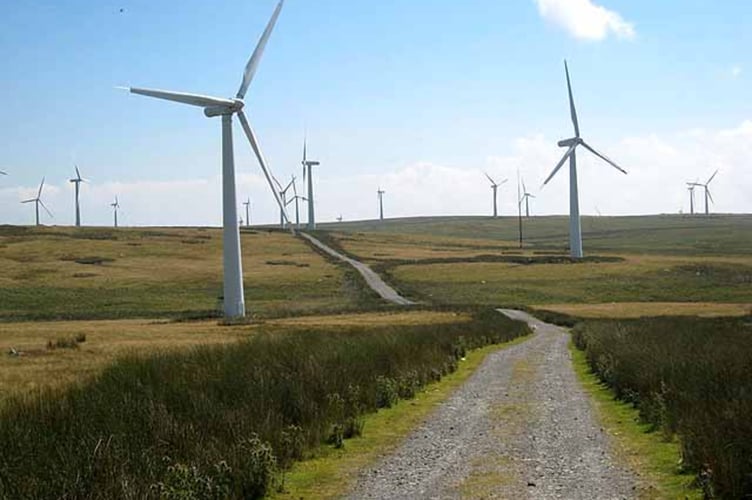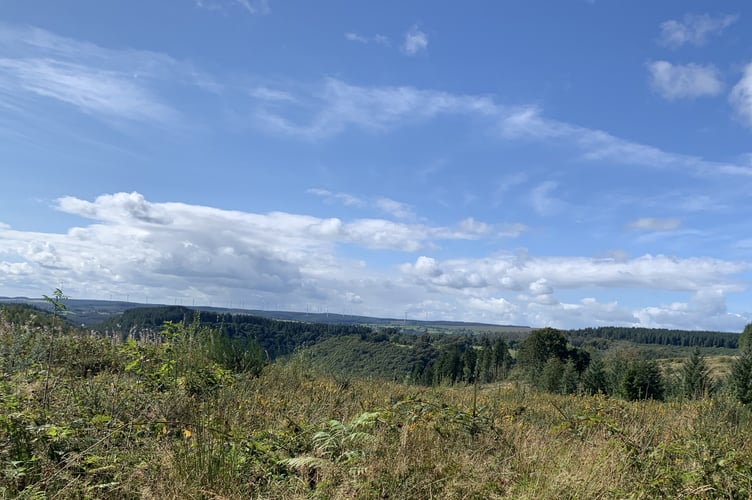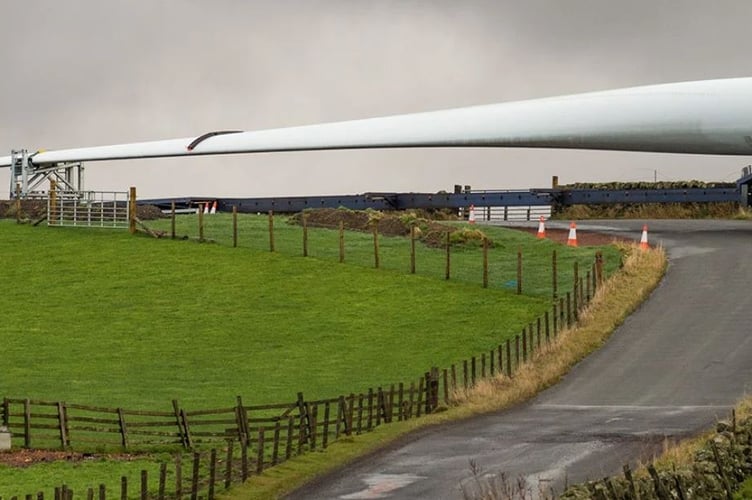The way Dr Jonathan Dean sees it, the people of mid and west Wales need to get angry: Get angry and then calm down and work together to stop the wind farm and pylon projects that are going to change the face of the nation forever.
He is an energy expert and trustee for the Campaign to Protect Rual Wales. CPRW has long raised concerns over the growing number of energy projects. And right now, the sheer size and scale of wind farms proposed from Gwynedd, Powys, Ceredigion, Carmarthenshire and Pembrokeshire means that a critical tipping point has been reached.
“It's not a question of number, it's location, size and capacity,” he says.
CPRW promotes a map that keeps track of the developments and, when viewed together, clearly shows how the developments, if all approved, will alter the Welsh countryside.
Because wind farms are considered to be developments of national significance (DNS), local county councils have little say in the planning process, with the files being handled by officials from the Welsh Government.
According to latest estimates by campaigners, 48 wind farms are in varying stages of application or approval right now – and more come almost weekly, certainly monthly. So why so many?
“Wales has never had a de facto ban on onshore wind like England did -neither did Scotland - so wind developers have concentrated on Wales and Scotland as the only places to ply their trade for many years,” he says. “As the Welsh Government have no say over what happens at sea, they have been unable to fill the Welsh seas with offshore wind like Westminster has done in the North Sea and the Scottish Government has done in Scottish seas.
“While devolution of the Crown Estate would help, it isn't strictly necessary, it just needs a Welsh Government to stand up to Westminster and demand more offshore wind.”
It’s not as if CPRW is against green energy, it simply wants a halt on the proposed terrain-based projects while the Welsh people can have a debate on what should happen – and who should control thew process.
“We need the distribution grid upgrading as soon as possible to meet the expected 2050 levels of electricity usage,” Dr Dean says.
“Smaller scale, maybe community owned, locally agreed developments that feed the distribution grid for local usage should be allowed,” adding that these should include both wind and solar projects.
“But bulk ‘merchant’ generators should not be allowed,” he adds.
“We need a Welsh Government that stands up for rural Wales and demands we have the use of our seas - we can produce everything we need, and more, just from the sea. For decades we have exploited offshore not onshore petroleum reserves, we need to do the same with wind power.
“We need a serious look at tidal. Not just tidal flow but also tidal range. As climate change advances we will need barrages and sea defences in any case just to stop flooding, so let's build barrages to generate power as well
“If power lines were evaluated according to the supposedly mandatory Treasury guidance, pylons would hardly ever be proposed. Undergrounding would be the norm.
“The current targets are set on renewables only - not low carbon. So, no amount of nuclear or carbon capture counts as far as the Welsh Government is concerned. This is utterly illogical.”
For MS Elin Jones, the sudden number of applications in recent months comes as a bit of a surprise.

“Many parts of the Cambrian Mountains are subject to new wind farm applications. In Ceredigion, these are mainly east of Aberystwyth and east of the Llanddewi Brefi-area. There have been very few new developments over the past 10-15 years, and suddenly they’ve all come at once,” she says.
“I’m not in principle against onshore wind developments. We need far more electricity into the future, as we become increasingly less able to rely on fossil fuel energy sources. A mix of renewable energy production is going to feature as the major component of electricity generation and rural Wales needs to contribute towards the renewable effort.
“However, these large developments on the Cambrians should not come at any price,” the MS warns.
“Firstly, we need to ensure that the developments contribute to strengthening the grid locally. They cannot solely be created to export energy out of the area.”
She says the grid locally, especially in the Aberystwyth area, is very weak and needs to have more capacity to ensure we can develop our economy and our transport infrastructure into the future – for our cars, buses and trains.
“Also, the Cambrians are environmentally important as peat bogs and to alleviate flooding downstream. Windfarm developments must be fully assessed to ensure that there are no unintended negative impacts on our environment and water systems.”
There are similar issues across the region, regardless of where the proposed wind farms are located.
In Brechfa in Carmarthenshire, the proposed state-backed Glyn Cothi wind farm is expected to generate the equivalent electricity used by 144,000 households
One resident said siting concrete foundations, tracks and turbines in a woodland ran counter to the Welsh Government’s National Forest for Wales plan.
In her view it also jarred with the now-removed requirement for farmers to have tree cover on 10 per cent of their land as part of the Sustainable Farming Scheme.
She said she did not oppose wind turbines in general but was worried about their impact on wildlife and what she claimed was ancient woodland in the area of Brechfa Forest where the Glyn Cothi turbines are proposed. “We are leaving a legacy to future generations of vast concrete foundations and carbon fibre blades which can’t be recycled.”
In North Pembrokeshire, Clydau Community Council strongly objected to a proposal for a 102-metre-high wind turbine at Sarnau Farm near Trelech, raising concerns of potential visual and noise impacts. Withdrawing the scheme, the applicants submitted new plans for a smaller, 64-metre turbine, but the council still expressed concerns about its potential impact on the landscape.

Formal plans for three wind turbines, up to 100 metres high were submitted to Pembrokeshire County Council in June for land close to Bluestone Holiday Park and the former Oakwood Theme Park. It was pointed out that the landscape already incorporates existing “detractors” such as wind turbines and the theme park’s rollercoasters.
If only the turbines were just 100 metres high. The next generation of turbines planned for Wales are larger – and simply getting blades to the sites would be a logistical nightmare.
With so many developments planned, is there a danger that opponents are guilty of nimbyism?
“I'm proud to be a nimby,” Dr Deans answers, “because next it might be you.
“Seriously, the whole nimby idea has been debunked by academics years ago, but it lives on with the public as a memorable catchphrase.
Accord Dr Dean, the National Energy System Operator is predicting that by 2050 Wales will produce over 50 per cent more electricity than it uses just from renewables, and that over 80 per cent of that will be from offshore wind in the Irish and Celtic Seas.
“This means Wales can easily achieve net zero using just offshore wind - anything more, absolutely anything more than that isn't needed to keep the lights on, isn't needed to heat homes and businesses and isn't needed to charge EVs.
For CPRW, the issue is simple.
“When was the Welsh public ever consulted on if it was happy for our countryside and landscape to just be used as a power plant?” Dr Dean asks.
Or, as MS Elin Jons notes: “It’s essential that local communities benefit meaningfully from windfarm developments – not just in the form of grants to community centres, but also to improved local services and reduced energy bills. Wind farm companies need to work closely with local councils to ensure community benefit is properly planned.
“I would support giving local authorities a greater say in these large infrastructure developments especially in assessing whether the cumulative impact of multiple developments is excessive,” she says.
So, is it time for a moratorium on the projects?
“There are very few, if any, of the current gold rush generation of proposals that I wouldn't like to stop.” Dr Dean says.
Across Wales, community groups are simply overwhelmed and are focused on fighting the individual projects rather than working in a coordinated and organised campaign.
“Our community is exhausted and confused by the multiple applications. The same individual public servants appear to be spending most of their time responding to the DNS planning process, instead of carrying out their work of helping to run the country,” notes Grace Lloyd, part of the Mynydd Maen Action Group based in Abercarn, Gwent.
“It is a dreadful waste of public money and resources to allow adjacent, interlinking DNS renewable energy applications to be submitted separately, when it is perfectly obvious they are intended to interconnect.
“This practice is also contradictory to the principle of fair public consultation and engagement,” she notes.
Imagine then, the paperwork involved in processing those almost 50 separate projects.
Ms Jones would like to see “the undergrounding of pylons as the technology exists to underground the cables effectively, and is already used on the continent.
“There should be greater use of off-shore tidal and wind. We are now seeing some of these projects given the green light around Pembrokeshire and south Wales. We’re unlikely to see Cardigan Bay become as a site for offshore renewables in the near future, due to the ecological protections in the Bay and the lack of major port infrastructure along the coast,” she says.
Dr Dean, however, believes the Senedd members are not doing enough when it comes to wind farms.
“No, and they know they are not,” he says. “They are deliberately harming rural Wales.
“Our [Freedom of Information request] about wind farms on peatland has lots of evidence they know they are doing harm and are not doing anything about it,” he asserts. “They even considered dropping their own policy to protect peatland in order to avoid having to explain why they were ignoring their own policy, and to avoid scaring off wind farm developers.”
“They have another policy to underground electricity lines - but wrote to tell me they have no evidence the policy has ever been used. Their own wind farms will not even use their own policy!
“They have a policy to protect best and most versatile farm land from development - yet approve solar farms on the nest and most versatile land, stating that climate change was a wholly exceptional circumstance - a circumstance they knew about when they put the policy in place,” he fumes. “Climate change is a whole exceptional circumstance?”
Right now, with a Senedd election coming in May, the next few months are critical in plotting the future course for mid and west Wales and its wind farms.
“The Senedd election is absolutely critical,” he says. “We need a government that addresses climate change but without destroying the very things we want to protect.”
List of wind farms
According to CPRW, there are application planned for:
Aberedw Energy Park
Abertillery wind farm
Alwen Forest wind farm
Banc Du Energy Park
Banc y Celyn energy park
Brechfa North wind farm
Bryn Cadwgan Energy Park
Bryn Gilwern Energy Park
Bryn Rhudd Energy Park
Bryngydfa wind farm
Calon y Gwynt Energy Park
Carnedd Wen wind farm
Carreg Wen Wind Farm
Clocaenog Dau Wind Farm
Convatec Green Manufacturing Hub
Craig y Geifr wind farm
Dragon Energy Park
Esgair Cwmowen wind farm
Esgair Ddu Energy Park
Esgair Galed Energy Park
Foel Fach Wind Farm
Foel Trawsnant wind farm
Gaerwen wind farm
Garn Fach wind farm (approved)
Garreg Fawr Energy Park
Glyn Cothi Wind Farm
Hirfynydd Renewable Energy Park
Lan Fawr Energy Park
Llanbrynmair wind farm
Llanwonno Energy Project
Lluest Y Gwynt wind farm
Llyn Lort Energy Park
Manmoel wind farm
Melin Court wind farm
Moel Chwa Energy Park
Mynydd Bedwellte wind farm
Mynydd Carn-y-Cefn wind farm
Mynydd Fforch-Dwm wind farm
Mynydd Llanhilleth wind farm
Mynydd Lluest y Graig wind farm
Mynydd Maen wind farm
Mynydd Mawr Energy Park
Mynydd Ty-talwyn Energy Park
Mynydd y Gaer wind farm
Mynydd y Glyn wind farm
Nant Ceiment Energy Park
Nant Mithil Energy Park
Newhouse Farm wind turbines
Pant y Mean wind farm
Rhiwlas Energy Park
Rhyswg wind farm
Trecelyn wind farm
Trecwn Green Energy Hub
Twyn Hywel Energy Park (approved)
Upper Lliw Energy wind farm
Upper Ogmore wind farm (approved)
Waun Hesgog Energy Park
Waun Maenllwyd wind farm
Y Bryn wind farm
Blaencothi Energy Park
Bryn Glas Energy Park
Bryngwyn Energy Park
Maesnant Energy Park
Mwdwl Eithin Energy
Nant Aman Energy
Nant y Maen
Orddu Energy Park
Tarenni Energy Park
Llyn Lort II
Derwydd Bach


-(1).png?width=209&height=140&crop=209:145,smart&quality=75)


Comments
This article has no comments yet. Be the first to leave a comment.